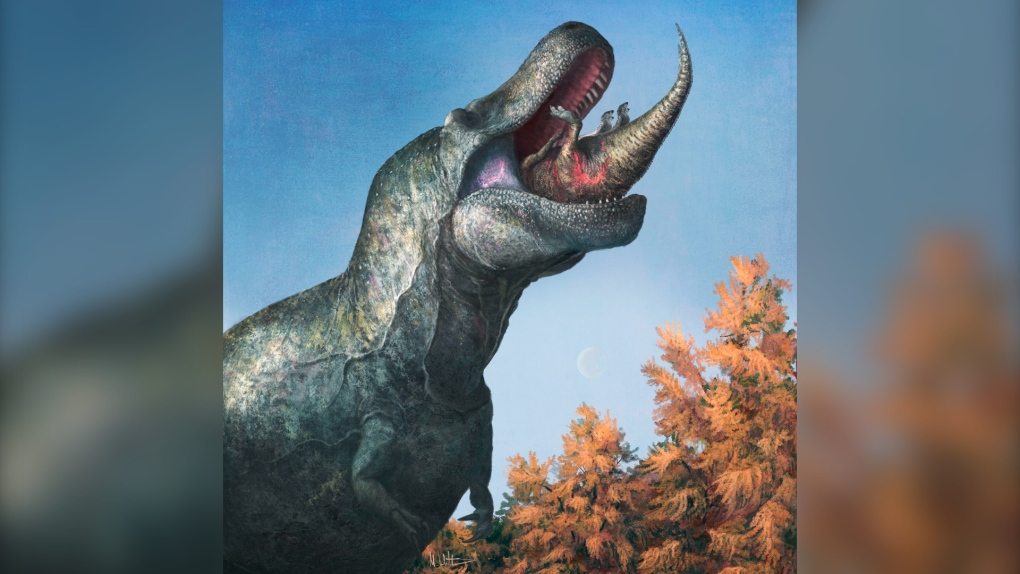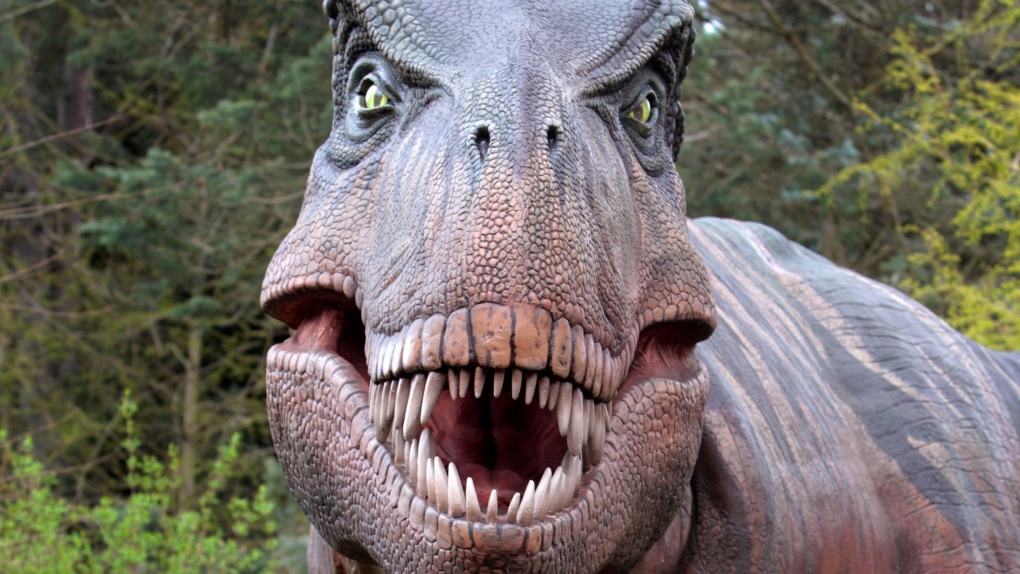
American millionaire Jonathan Lehrer denied bail after being charged with killing Canadian couple
American millionaire Jonathan Lehrer, one of two men charged in the killings of a Canadian couple in Dominica, has been denied bail.
The Tyrannosaurus rex is often shown baring massive, sharp teeth, like the ferocious creature in "Jurassic Park." But new research suggests that this classic image might be wrong.
The teeth on T. rex and other big theropods were likely covered by scaly lips, concludes a study published Thursday in the journal Science. The dinosaur's teeth didn't stick out when its mouth was closed, and even in a wide open bite, you might just see the tips, the scientists found.
The research is the latest in a long back-and-forth over how dinosaur mouths really looked.
Recent depictions show big teeth jutting out of the dinosaurs' jaws, even when closed. Some thought the predators' teeth were just too big to fit in their mouths, said study author Thomas Cullen, a paleontologist at Auburn University in Alabama.
When researchers compared skulls from dinosaurs and living reptiles, though, they found this wasn't the case. Some large monitor lizards actually have bigger teeth than T. rex compared to their skull size, and can still fit them under a set of scaly lips, Cullen said.
The scientists also found clues in the pattern of wear and tear on tooth surfaces.
For a creature like a crocodile, whose teeth stick out of its mouth, the exposed part gets worn down quickly -- "like someone's taken a sander to the side of the tooth," said another study author Mark Witton, a paleoartist at England's University of Portsmouth.
 This illustration provided by Mark P. Witton in March 2023 depicts a juvenile Edmontosaurus being eaten by a Tyrannosaurus rex with a lipped mouth. (Mark P. Witton via AP)
This illustration provided by Mark P. Witton in March 2023 depicts a juvenile Edmontosaurus being eaten by a Tyrannosaurus rex with a lipped mouth. (Mark P. Witton via AP)
But when researchers analyzed a tooth from a Daspletosaurus, a T. rex relative, they found it was in good condition and it didn't show that uneven damage pattern.
With this evidence and other clues from the dinosaurs' anatomy, the study makes a good case for lipped tyrannosaurs, said University of Maryland paleontologist Thomas Holtz, who was not involved with the study.
Still, "we're not talking kissy lips," he pointed out -- they'd be thin and scaly like those of the Komodo dragon, a large lizard.
It's not the first time our depictions of dinosaurs have been called into question: Other research has shown that T. rex was more hunched over than we used to think, and that fierce velociraptors probably sported feathers.
Most of what we know about dinosaurs comes from their bones, but it can be harder to get clear answers about soft tissues like skin, which usually aren't preserved as fossils.
Adding lips may make dinosaurs look a little less ferocious, but it also makes them feel more realistic, Witton said.
"You don't really see a monster," he said. "You see an animal."
 This April 28, 2011 file photo shows a Tyrannosaurus rex dinosaur replica at the Woodland Park Zoo in Seattle. (AP Photo/Elaine Thompson)
This April 28, 2011 file photo shows a Tyrannosaurus rex dinosaur replica at the Woodland Park Zoo in Seattle. (AP Photo/Elaine Thompson)
The Associated Press Health and Science Department receives support from the Howard Hughes Medical Institute's Science and Educational Media Group. The AP is solely responsible for all content

American millionaire Jonathan Lehrer, one of two men charged in the killings of a Canadian couple in Dominica, has been denied bail.
Cabinet minister Dominic LeBlanc says he plans to run in the next election as a candidate under Prime Minister Justin Trudeau's leadership, amid questions about his rumoured interest in succeeding his longtime friend for the top job.
A male columnist has apologized for a cringeworthy moment during former University of Iowa superstar and college basketball's highest scorer Caitlin Clark's first news conference as an Indiana Fever player.
The judge presiding over the trial of a man accused of fatally running over a Toronto police officer is telling jurors the possible verdicts they may reach based on the evidence in the case.
Nearly half of China's major cities are suffering 'moderate to severe' levels of subsidence, putting millions at risk of flooding especially as sea levels rise.
Health Canada will change its longstanding policy restricting gay and bisexual men from donating to sperm banks in Canada, CTV News has learned. The federal health agency has adopted a revised directive removing the ban on gay, bisexual and other men who have sex with men, effective May 8.
Prince Harry, the son of King Charles III and fifth in line to the British throne, has formally confirmed he is now a U.S. resident.
The United States has vetoed a widely backed UN resolution that would have paved the way for full United Nations membership for the state of Palestine.
Sophie Kinsella, the best-selling author behind the 'Shopaholic' book series, has revealed that she is receiving treatment for brain cancer.

Kevin the cat has been reunited with his family after enduring a harrowing three-day ordeal while lost at Toronto Pearson International Airport earlier this week.
Molly Knight, a grade four student in Nova Scotia, noticed her school library did not have many books on female athletes, so she started her own book drive in hopes of changing that.
Almost 7,000 bars of pure gold were stolen from Pearson International Airport exactly one year ago during an elaborate heist, but so far only a tiny fraction of that stolen loot has been found.
When Les Robertson was walking home from the gym in North Vancouver's Lower Lonsdale neighbourhood three weeks ago, he did a double take. Standing near a burrow it had dug in a vacant lot near East 1st Street and St. Georges Avenue was a yellow-bellied marmot.
A moulting seal who was relocated after drawing daily crowds of onlookers in Greater Victoria has made a surprise return, after what officials described as an 'astonishing' six-day journey.
Just steps from Parliament Hill is a barber shop that for the last 100 years has catered to everyone from prime ministers to tourists.
A high score on a Foo Fighters pinball machine has Edmonton player Dave Formenti on a high.
A compound used to treat sour gas that's been linked to fertility issues in cattle has been found throughout groundwater in the Prairies, according to a new study.
While many people choose to keep their medical appointments private, four longtime friends decided to undergo vasectomies as a group in B.C.'s Lower Mainland.